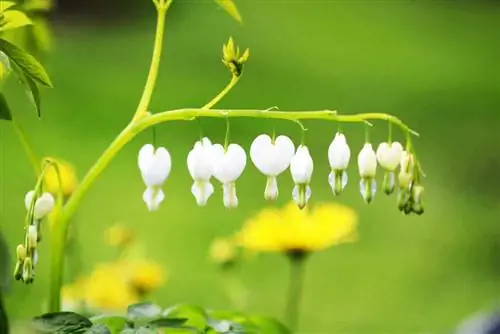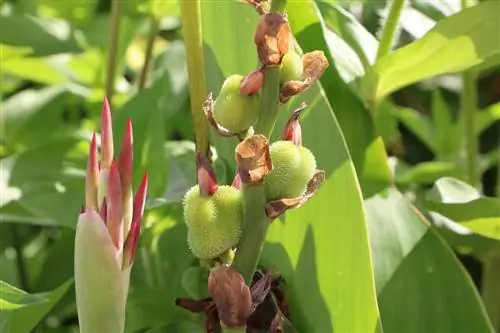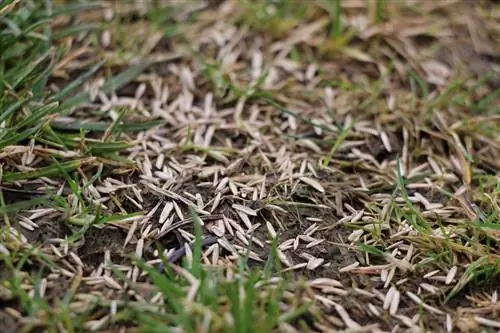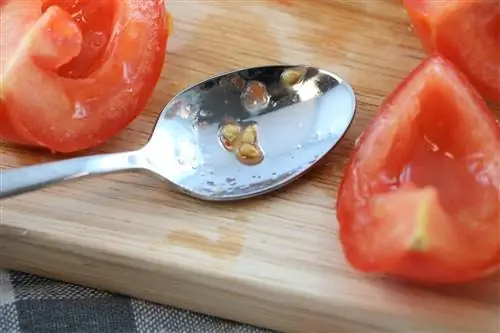- Author admin [email protected].
- Public 2023-12-17 03:39.
- Last modified 2025-06-01 06:48.
At first glance you might think that sowing is a simple matter. But in many cases, soil, moisture and warmth are far from enough. Instead, the seeds need an external stimulus to germinate in the first place. You can find out how to artificially create this stratification in the following instructions:
Why stratify at all?
In nature it is generally intended that plants spread their seeds in a variety of ways after fruit ripening. However, they should not germinate and develop into plants until the following spring. This gives the seedling as much time as possible to prepare for the next winter with all its challenges through growth and strengthening.
So that this delay in germination actually occurs, nature has built in different mechanisms to inhibit germination:
- Inhibition by organic acids in the pulp - in flesh-bearing stone fruits (peach, cherry, bird cherry, wild rose, etc.)
- Inhibition by hormone- and enzyme-like substances in the seedling or seed coat (e.g. witch hazel, viburnum, yew, etc.)
- Mechanical germination inhibition, often combined with enzymatic inhibitors (especially woody plants with hard-shelled seeds (beech, oak, chestnut, etc.)
How to stratify - instructions
Since there are different mechanisms of germ inhibition, different approaches are required to overcome it. Since different inhibitors usually occur in combination in nature, it may be necessary to combine the various measures for stratification:
Stratification of organic acids as germination inhibitors
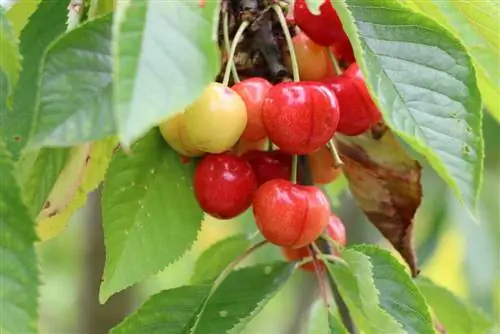
You can argue about whether this is a real stratification, as is repeatedly described in the literature. The fact is that factors that inhibit germination are specifically eliminated here in order to ensure that the plant seeds can germinate.
Application
for flesh-bearing fruits
Inhibition process
- Development of organic acids in the pulp through fruit ripening
- Effect of acids on fruit core
- Onset of an inhibitory effect
Procedure for removing the inhibition
- Lay the fruits out in the open air and sun
- Wait for the pulp to start rotting
- Remove meat residue from seeds, e.g. by rubbing or crushing with your hands or between two stone or wooden plates
- Wash kernels in water to avoid further rot
- Dry the kernels to prevent immediate germination
- Store dry and airtight until sowing
ALTERNATIVE
A second way, in addition to removing the pulp and fruit acids, is to harvest the fruit before it is fully ripe. In this way, development is stopped before the acids are produced and the seeds can be obtained to propagate the plant as described above.
Tip:
This form of germination is the simplest and easiest variant to implement. However, you should proceed carefully. Moisture in particular can become a problem due to an unwanted stimulus to germination or favorable conditions for the reproduction of putrefactive bacteria.
Stratification for hormone or enzyme-like substances
The most common form of stratification is used when hormones or enzymes appear as development inhibitors. This is called cold stratification.
Application for
Cold germination, whose seeds require a cold phase to germinate
Inhibition process
- Development of inhibitory messenger substances in the seedling or the seed coat
- Decomposition of messenger substances due to cold phase
Procedure for stratification
- Fill the container with sand, or alternatively sand and peat
- Put the cleaned seeds into the substrate and fold in
- Moisten the substrate, e.g. by carefully watering it
- Store the container in a cool location, e.g. basement, garage or refrigerator
- Ideal temperature range: 2 to 8 degrees Celsius
- Turn the substrate including the seeds regularly, e.g. weekly, to create even moisture and roughen the seed coat with grains of sand (better swelling)

In the past, the individual seeds were simply embedded in layers in the substrate and then usually placed outdoors. However, stratification becomes more effective if consistently cool temperatures are maintained. Outdoors, for example, a particularly sunny day or a warm phase in autumn or spring can significantly lengthen the duration.
Tip:
The use of substrate for storage serves, on the one hand, to retain moisture. In addition, it also provides a certain level of protection against germs and other harmful pathogens. Therefore, never use humus or garden soil, as both substances contain high levels of exactly these substances that should be avoided.
Special case: Frost germinator
Frost germinators represent a certain special form of cold stratification. These are primarily early bloomers, such as crocus or snowdrops. Not only do you need cool temperatures, you need actual frost. The procedure corresponds to cold stratification. However, the ideal temperature range here is just below 0 degrees to around minus 5 degrees Celsius.
Stratification with mechanical germination inhibition

Finally, what remains is a kind of mixed form of the cold stratification already discussed and an additional form to overcome germination inhibitions. The mechanical inhibition that is now the focus is usually accompanied by chemical messengers that can be broken down by a cold phase. This is why we speak of a so-called warm-cold stratification, since the well-known cold stratification is preceded by a warm phase.
Application for
Seed shapes with hard shell
Inhibition process
- Mechanical barrier of the seed coat against germination-stimulating influences, such as heat and moisture
- Delay in moisture access to the core due to the high resistance of the shell
- Definition of the delay by the duration of swelling of the seed coat, germination only possible after swelling and breaking up
Procedure for removing the inhibition
- Preparation of the individual seeds as for cold stratification including embedding in substrate
- First location with ambient temperature of 20 degrees Celsius or slightly above
- Duration of stay around 2 to 4 weeks
- Effect: faster swelling and breaking of the seed coat
- Lowering the temperature or changing location as with cold stratification

